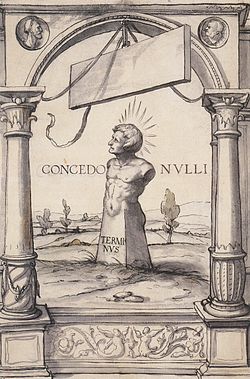
Back Терминус (митология) Bulgarian Terminus Catalan Terminus (mytologie) Czech Terminus (Mythologie) German Termino (dio) Esperanto Término (dios) Spanish Terminus (jumala) Finnish Terminus (mythologie) French טרמינוס HE Terminus (isten) Hungarian

| Part of a series on |
| Roman mythology |
|---|
| Major gods |
| Topics |
| Other minor Roman deities |
|
|
In Roman religion, Terminus was the god who protected boundary markers; his name was the Latin word for such a marker. Sacrifices were performed to sanctify each boundary stone, and landowners celebrated a festival called the "Terminalia" in Terminus' honor each year on February 23. The Temple of Jupiter Optimus Maximus on the Capitoline Hill was thought to have been built over a shrine to Terminus, and he was occasionally identified as an aspect of Jupiter under the name "Jupiter Terminalis".
Ancient writers believed that the worship of Terminus had been introduced to Rome during the reign of the first king Romulus (traditionally 753–717 BC) or his successor Numa (717–673 BC). Modern scholars have variously seen it as the survival of an early animistic reverence for the power inherent in the boundary marker, or as the Roman development of proto-Indo-European belief in a god concerned with the division of property. [citation needed]